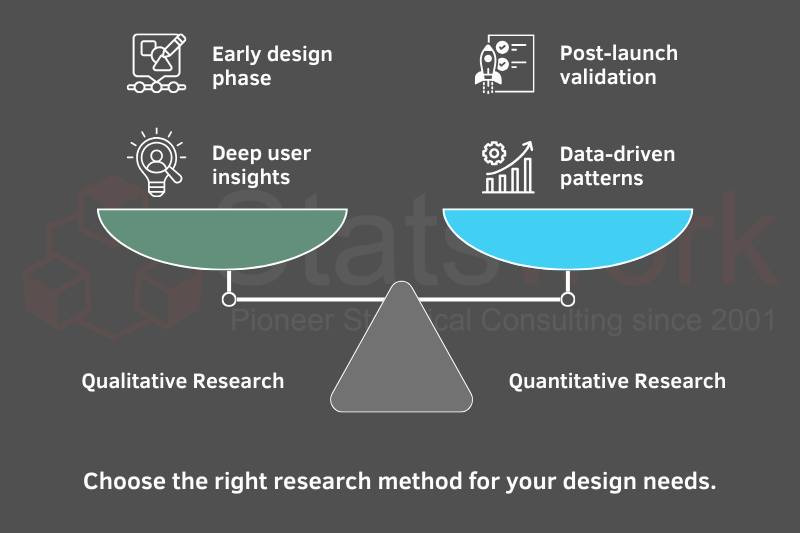 Celebrate the season with exclusive savings from Statswork!
Click to claim your gift!
Celebrate the season with exclusive savings from Statswork!
Click to claim your gift!
 Click to Unlock
Click to Unlock your Offer
 Celebrate the season with exclusive savings from Statswork!
Click to claim your gift!
Celebrate the season with exclusive savings from Statswork!
Click to claim your gift!
 Click to Unlock
Click to Unlock 
As the data collection methods have extreme influence over the validity of the research outcomes, it is considered as the crucial aspect of the studies
May 2025 | Source: News-Medical
Recognizing the differences between qualitative and quantitative data is vital for researchers, businesses, and students making decisions that are well informed. Qualitative and quantitative data provide different insights in research and analysis, and understanding when to use either form, and how to exploit their mutual benefits, provides enriching insights to research and decisions. [1]

Quantitative data encapsulates anything that can be measured or counted. Think of it like data in numbers: survey result scores, number of clicks, sales numbers, or amount of time a user stayed on a website. This kind of data includes the answer to questions like “How many?”, “How much?”, or “How often?”, and is valued for its objectivity, and ability to be scaled up.
Examples:
Researchers use quantitative data, when identifying patterns, or relationships, at scale. Using methods like surveys, online polling, experiments, and site analytics, it is easy for researchers to enter quantitative data in search for a statistically significant finding. [1] [2]
Qualitative data refers to the description of qualities, experiences, or characteristics. Qualitative data is non-numeric data that can capture words, opinions, stories, or even images. Qualitative data is best suited for the exploration of “why?” questions or “how?” questions- which helps to explain motivations or circumstances that we cannot illustrate with numbers alone.
Examples:
Qualitative data can come from interviews, focus groups, open-ended surveys, or observational fieldwork. Qualitative data helps us find themes and insights, provides the ability to see user motivations, and allows us to see a richer and deeper sensibility around the issue. [1][2]
| Aspect | Quantitative Data | Qualitative Data |
|---|---|---|
| Format | Numerical (counts, scores, values) | Descriptive (words, images, stories) |
| Questions Answered | How many? How much? How often? | Why? How? What kind? |
| Collection | Surveys, analytics, experiments | Interviews, focus groups, observation |
| Analysis | Statistical, mathematical | Thematic, narrative, content analysis |
| Objectivity | High; replicable and scalable | Subjective; context-rich, flexible |
| Output | Graphs, charts, statistical reports | Quotes, themes, narratives |
Suppose a software company is preparing to release a new app feature. Quantitative data says “40% of users try the feature within the first week.” But only qualitative feedback will tell us why—maybe users like the simplicity, or maybe they are confused by the layout. Without either, the team knows what is happening without knowing why.
Benefits and Limitations
Quantitative
Qualitative

In summary, when conducting thorough research and making informed decisions, qualitative and quantitative data is crucial. Statistical or quantitative data includes measurable, objective data that shows patterns, trends, and relationships and is most useful for testing hypotheses, generalizing, or performing inferential statistics. Qualitative data includes rich, contextual, and nuanced data that will allow researchers to understand individual motivations, perceptions, and experiences in ways that numbers cannot communicate. [1][2]
By integrating both methods, researchers not only have a general picture of “what” is going on, but they will then have a multi-dimensional understanding of “why” and “how” it happens. Ultimately, by combining qualitative and quantitative analysis, organizations and researchers will make knowledgeable, reasonable, and real-world pertinent conclusions. [4][5][6]
Are You Ready to Elevate Your Research?
At Statswork, we can assist organizations and individuals in understanding qualitative and quantitative data with qualified individuals conducting custom analysis, rigorous reporting, and relevant conclusions for your next great study. Take full advantage of your qualitative and quantitate; connect with Statswork today for a complimentary consultation and scale the impact of your next big discovery!
WhatsApp us